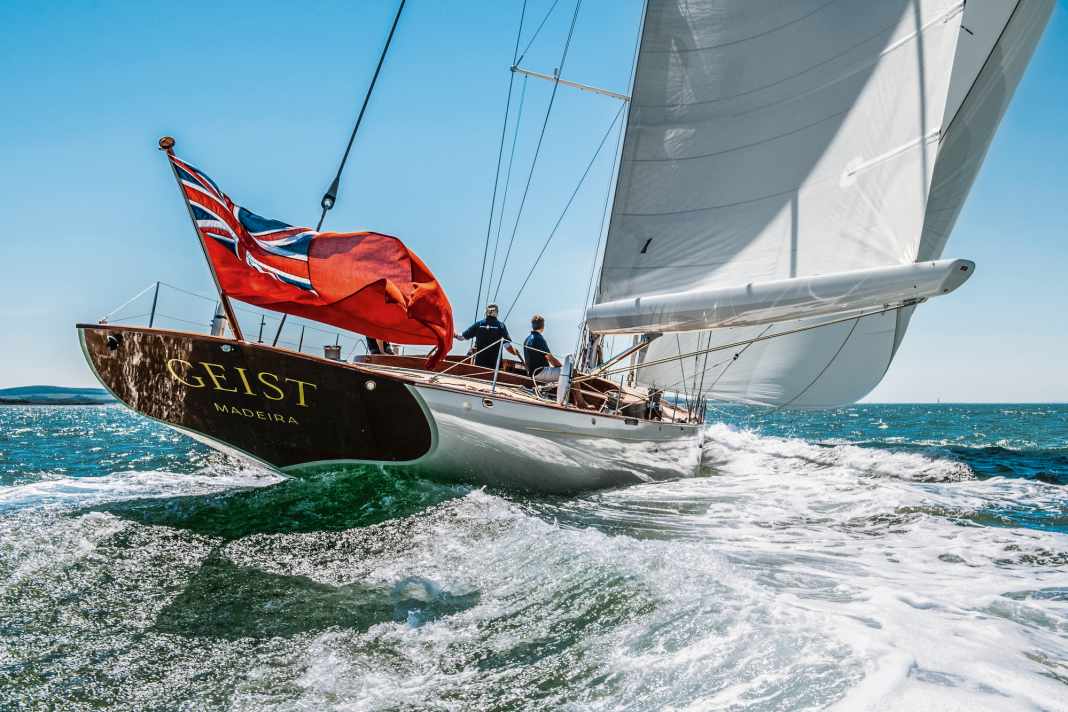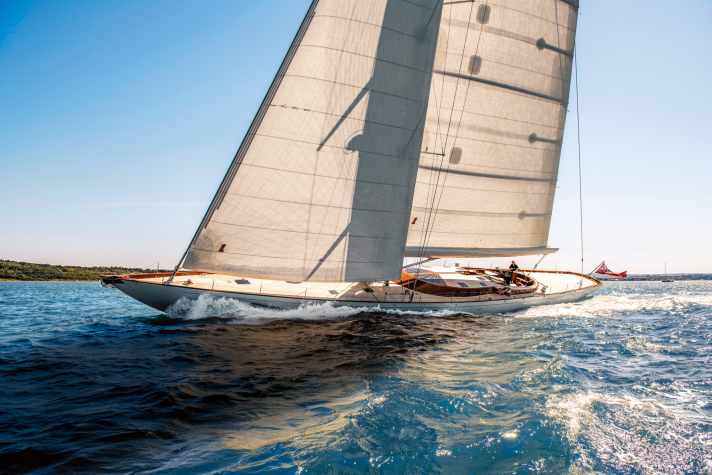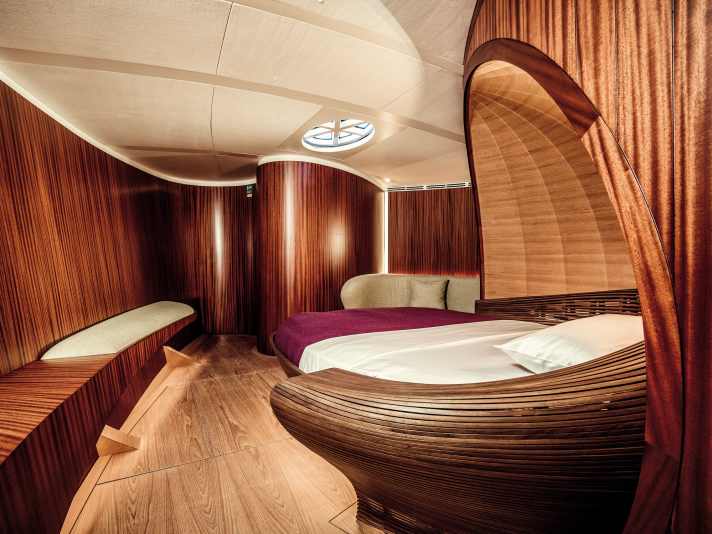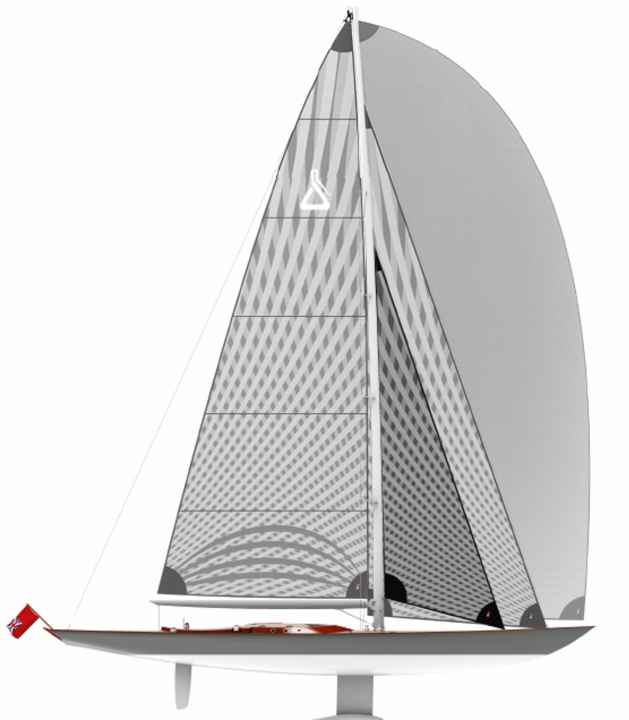





The essence of sailing is the constant confrontation with the elements. However, the larger the yacht, the greater the separation from the water. The distance increases with the freeboard not only geometrically, but also mentally. This equation was not what the "Geist" owner had in mind: "You gain space at the price of distancing yourself from nature. But it was the proximity to the environment that attracted me to yachts. This realisation became a central point of my inspiration."
It is not surprising that these words come from the mouth of a sailor who previously enjoyed a Spirit 52 for ten years. "I have never regretted it, not for a day, and have had wonderful times on her with friends or exploring the unspoilt corners of the Mediterranean with my wife. I like her very much."
It should be flat, slim and elegant
We are talking about a boat that was skilfully crafted from wood. When he made a detour to Spirit in Ipswich on the North Sea to entrust his beloved 52 to the shipyard crew for overhaul work, the idea of a larger yacht had already matured. However, the man had no intention of immediately enlarging from 16 to 34 metres. An extremely fruitful exchange took place and they ended up with 90 feet. A model was produced and presented. Sean McMillan, Spirit founder and designer, remembers: "He said she had to be more elongated, with the same width and the lowest possible freeboard. Basically, he told me to make her as elegant as possible."
The owner's specification thus represented an alternative to the idea of more cabins, and the "Geist" owner also enthuses: "The long overhangs and the low freeboard were decisive for me. I wanted a flush deck so that the elegant lines are not interrupted. She looks majestic on the water."
The best of two worlds
J-Class yachts rely on a similar elegance formula. McMillan worked with Sparkman & Stephens ten years ago on a new J-Class for a potential US customer. "The boats are beautiful, but weigh 170 tonnes and don't exceed 14 knots. I've never been interested in replicas. I design elegant, contemporary yachts that can be sailed as well as possible," the designer explains. Like all Spirit models, "Geist" relies on a modern underwater hull with a fixed T-keel and free-standing spade rudder. Other signets from Spirit's classic line can also be found: the heart-shaped stern ends in a sloping flat batten, the superstructure rises very flat and is crossed at the sides by portholes and at the top by semi-circular windows that open up like a fan.
A comparison with the 30 metre long "Gaia", Spirit's first foray into the supersailer segment, which was launched 13 years ago, comes to mind. But McMillan waves it away: "I started with a blank sheet of paper and worked according to the Pure Thought design process, where there are no compromises; I draw the way I think is right in terms of looks and performance. When it came to the 111, this approach and the 52 resonated as a reference."
Three-month design phase and keel laying
The Spirit CEO designed the 52 for himself 15 years ago. There was one important restriction to consider with the 111: "The headroom had to be two metres, as the owner is quite tall. So I curved the cross-section of the deck slightly." This is not a design feature that catches the eye of the observer. It's a different story with the deck moulding: "It's the most important line - it determines how the yacht looks. I can't remember how many times I drew it for 'Geist'." He still uses the same method today, sometimes with Straklatte. During the three-month design phase, McMillan barely came out from behind the drawing board and only had his designs translated into a 3D model by Geist's own engineering department once they had been approved by the owner.

The wooden hull was then laid on the keel, always under the supervision of McMillan: "Someone has to oversee everything so that every little detail is perfect." The Spirit hulls are grown using a tried-and-tested process that is a mixture of moulding and moulded gluing. The 50 millimetre thick "Spirit" planking is made of Canadian Douglas fir, which is similar to pine wood. Cold-glued and using epoxy resin, four diagonal layers of khaya veneer wood, also known as African mahogany, were applied to the outer skin. The beautifully shaped wooden structure is crossed amidships by a steel frame, to which shrouds are attached on the deck side and the keel and mast are attached on the hull side.
Wood is the core of Spirit Yachts
Spirit Managing Director Nigel Stuart describes the wood procurement process: "We purchased all the material for the 111 directly from the source, had it sawn there and transported it in the longest possible lengths." The owner visited the shipyard regularly, and project manager Jens Cornelsen from Glückstadt also paid a visit to the Spirit halls about once a month on his behalf. "I enjoyed experiencing every phase of development. Wood is not only beautiful, it is also such a versatile building material. I got to know all the boat builders involved," says the owner.
The exchange became even more intense after Spirit had turned the hull and the interior was ready to be fitted out. One reason for this was the unusual source of inspiration: the curved canyons of Antelope Canyon, which the "Spirit" owner visited during a holiday in the US state of Arizona.
The classic "Geist" look with its penchant for overhangs only allows the living areas just over half of the overall length, which is fitting as the owner couple sails without a crew. British studio Rhoades Young Design translated the organic free forms of the canyons into a living environment below deck.
Rendezvous of the radii
The wooden boat builders purchased two sustainably reforested Sipo trees in West Africa for the entire interior. The mahogany-like wood is used for the walls and built-in furniture in the saloon, such as the kidney-shaped bench seat on the starboard side, which runs into the wall like a helix - while maintaining the grain pattern. The floor is made of teak, and apart from two transverse frames, none of the walls protrude upwards. Amidships is a semi-open seating area made of American walnut, classically moulded in 2000 man-hours using hot steam. The round glass table is fitted with a waisted foot ring made of 64 rods. The galley consists primarily of a coverable brass sink and an induction hob, which is ventilated through a window hatch. The worktop's sash moulding is a work of art in itself: The pleasing round profile winds in iridescent radii.
There are no cupboards, light switches or sockets, and thanks to the concealed handles, there are no (refrigerated) cupboards to be seen. The owner describes his aesthetic vision: "I don't want any clutter to distract from the beauty and warmth of the wood and the craftsmanship. The interior will evolve with the use of the yacht, but above all it will remain a clean space."

The transition to the forward owner's area is seamless thanks to a wall that looks like a steel sculpture turned into wood by US sculptor Richard Serra and actually represents a bulkhead. The double bed, which is integrated into a hemisphere and creates a cocoon-like cosiness, inevitably catches the eye.
Lighting effects and staging of the light sources
A bedside table flows out of the walnut headboard - the open bar construction creates indirect lighting effects. "The beds and the bench seat in the saloon are inspired by the furniture we have at home," reveals the owner, who requested wooden washbasins and shower trays for the bathroom. A double cabin is situated diagonally aft to starboard, which, in contrast to the two aft VIP cabins, has an angular shower instead of a cylindrical one.
As there are no windows throughout the hull, the owner and shipyard spent a long time thinking about how natural light could warm up the interior and create an inviting atmosphere. The owner: "The spectrum of natural light balances out a reactive lighting system so that the interior always feels peaceful and is never punctuated by harsh light." Like the intensity of the LEDs, the opening of the doors is controlled by sensors.
"That kept us busy for a good five months," says Nigel Stuart about the unforeseen increase in complexity. If the power circuit is interrupted, the door latches are released.
In addition to shape and material, sustainability is the big issue
Environmental friendliness played a major role at an early stage. After some discussion, the decision was made in favour of the all-electric version - with maximum autonomy. The "Geist" owner explains his self-sufficient life on board: "I like to lie at anchor in a quiet bay, far away from crowded marinas. We want to generate the energy we need on a day's sailing."
The consumers are kitchen appliances, hot water, heating, air conditioning and the Torqeedo drive train with a 100-kilowatt motor. This becomes a power supplier via the propeller and under sail, as Nigel Stuart confirms: "The system is still under development, but at peak times we generated 6 kilowatts. From the Solent to the east coast, it was a constant 3 to 3.5 kilowatts with an average of 25 knots of wind and 12.5 knots of boat speed."
It is powered by four high-voltage batteries of 40 kilowatt hours each from BMW's i-series, which together account for a good tonne of the displacement of 58 tonnes. Weight is saved, however, in the hull insulation, for example, which is no longer required thanks to the positive properties of wood. Lewmar's new hydraulic system for the winches requires 90 per cent less oil and is correspondingly lighter.
The green thread continues to spin
The watermaker runs with energy recovery, while the refrigerator and freezer reduce consumption thanks to special insulation. The diesel generators operate at variable speeds and only start up when needed. At 80 per cent capacity, they charge the batteries in two hours or supply power directly to the electric drive.
What about the loss of speed when the propeller is unfolded under sail and harvesting energy? Spirit Managing Director Nigel Stuart waves this away: "This is only a fraction compared to the power of the sails, which is equivalent to around 150 kilowatts. We're talking about four percent drag, which would be compensated for by optimised sail trim."
The sail wardrobe consists of a furling main, jib, staysail, reacher and gennaker, each with an integrated furling system. Project manager Jens Cornelsen chose the British offshoot of the Italian OneSails Group because it has experience with Spirit yachts - and the 4T Forte laminate is recyclable, which has even been ISO-certified. Incidentally, the material is also being used on two boats during the Vendée Globe single-handed world regatta that is currently taking place.
Sculpture suitable for regattas
The owner also wants to take part in regattas and sail with few hands. Nigel Stuart reports on the transfer from Gosport to Ipswich: "My three fellow sailors had never been on board before - but we were able to sail off without a one-day briefing. The autopilot was off, of course. It was the best sailing day of my life."
Sean McMillan agrees: "'Geist' is very easy to sail. In many ways she's like a big dinghy. You only become aware of her dimensions when you have to manoeuvre. All the functions work at the push of a button, but you don't want to rush things with the high forces in the rig." As a designer and sailor, Spirit founder Sean McMillan was naturally very keen to tease out as much performance as possible: "In 12 knots of wind, we reached a maximum boat speed of 14 knots on the beam. In the right conditions, well over 20 knots is possible."
That leaves the decoding of the name, which correlates perfectly with the white sailing dress and the elegance of the hull. "I talked a lot about the name with my wife and the Spirit team. I wanted it to be simple and original. 'Geist' refers to my German origins and is a tribute to Spirit for building such a special yacht," explains the owner, who is spending his first "Geist" season in the Caribbean. Always close to the water.

Technical data "Ghost"
- Design engineer:Sean McMillan
- Interior design:Rhoades Young
- Torso length:33,90 m
- Waterline length:24,00 m
- Width:6,40 m
- Depth:4,05 m
- Weight:58 t
- Sail area on the wind:450 m2
- Sail carrying capacity:5,5
This article first appeared in YACHT 02/2021 and has been updated for this online version.

